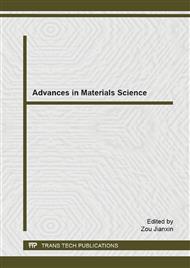p.391
p.395
p.401
p.407
p.411
p.415
p.419
p.424
p.429
Influence of Portland Cement Addition in the Physical and Mechanical Properties of Epoxy Resin
Abstract:
This research evaluated, with the of the analyses of variance (ANOVA), a composite material based on epoxy matrix phase reinforced with Portland cement (CP-II) particles (0%wt [100%wt of resin], 20%wt, 40%wt, 60%wt). The response-variable investigated were modulus of elasticity (E) and compressive strength (S), bulk density (ρB), apparent density (ρA) and porosity (P). The highest values of the modulus of elasticity were provided from the composites manufactured with 40wt% of cement addition. The inclusion of 60% of cement implies in a reduction in the mechanical properties when compared with the results of the composite manufactured with 40% of cement. For the physical properties, the gradually inclusion of cement provides increasing in the density of the composites, and reduce the porosity of the materials manufactured.
Info:
Periodical:
Pages:
411-414
Citation:
Online since:
February 2015
Keywords:
Price:
Сopyright:
© 2015 Trans Tech Publications Ltd. All Rights Reserved
Share:
Citation:


